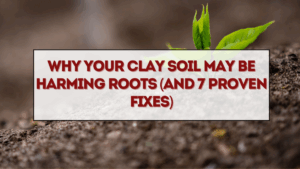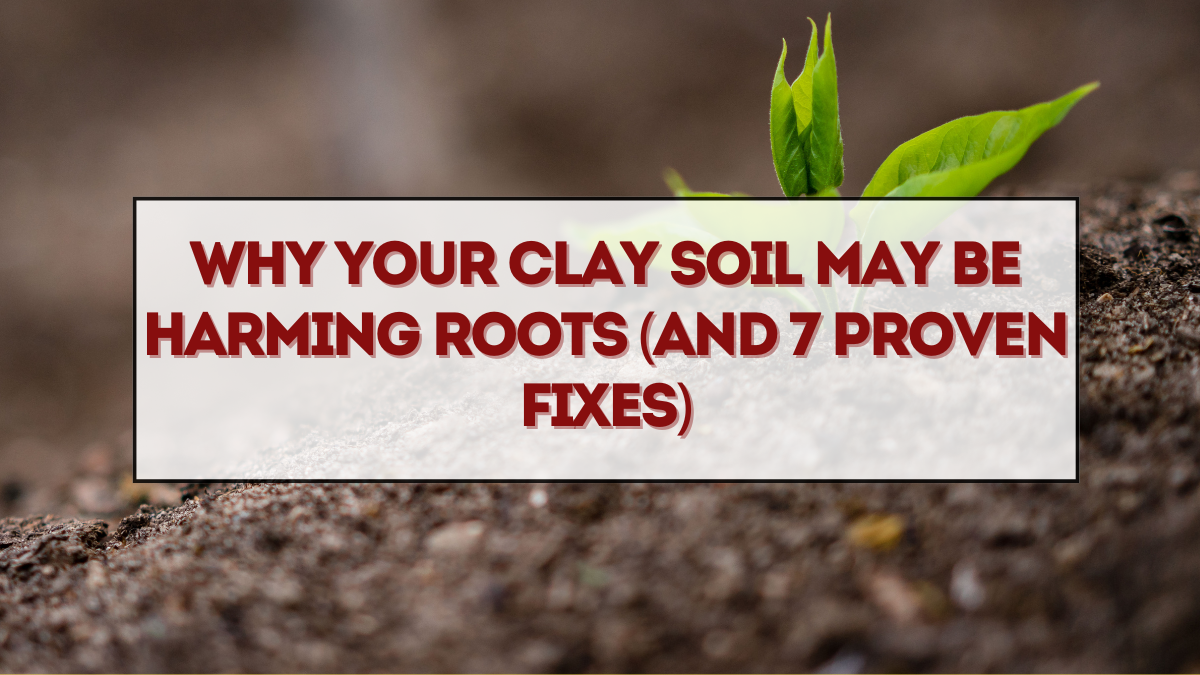Clay soil is one of the most challenging soil types for gardeners. While it is nutrient-rich, its dense structure can suffocate plants, block drainage, and prevent roots from spreading properly. For many homeowners, clay soil leads to stunted growth, yellowing leaves, and weak root systems that never establish fully.
If you’ve wondered why plants struggle despite fertilizing and watering regularly, the culprit may be your soil. This guide explains why clay soil harms roots and provides seven proven fixes to improve structure, boost drainage, and give your plants the healthy growing environment they deserve.

Why Clay Soil Causes Problems
Clay soil has very fine particles that pack tightly together. This density creates several challenges:
-
Poor drainage: Water pools on the surface and saturates roots, leading to rot.
-
Compaction: Roots struggle to push through the dense texture.
-
Low oxygen levels: The tight soil particles limit airflow, depriving roots of essential oxygen.
-
Slow warming: Clay retains water and stays cooler in spring, delaying planting seasons.
While clay soil naturally holds nutrients well, plants cannot use them efficiently if roots are trapped in poorly aerated ground.
Signs That Clay Soil Is Harming Roots
Your garden may be showing distress without you realizing it’s soil-related. Watch for these symptoms:
-
Puddles or waterlogging after rainfall.
-
Cracks in the ground during dry weather.
-
Plants with yellowing leaves despite fertilization.
-
Shallow or twisted root systems when plants are pulled up.
-
Stunted growth compared to expected plant size.
Recognizing these signs early allows you to apply solutions before permanent damage occurs.
Fix 1: Improve Structure with Organic Matter
Adding organic matter is the single best fix for clay soil. Compost, aged manure, and leaf mold all help break apart dense particles, creating air pockets and improving drainage.
How to apply:
Spread 2–3 inches of compost over beds and mix it into the top 8 inches. Repeat annually to gradually transform heavy clay into a friable, loamy soil.
Fix 2: Use Gypsum for Better Drainage
Gypsum (calcium sulfate) works by binding clay particles together, reducing compaction, and improving drainage without altering soil pH. It’s especially useful in areas where clay is sodic (high in sodium).
How to apply:
Spread gypsum evenly across soil at the recommended rate on the package, then water thoroughly. Combine with organic matter for long-term improvement.
Fix 3: Build Raised Beds
If your clay soil is extremely dense, creating raised beds offers an immediate solution. By filling them with a loamy mix of compost, topsoil, and sand, you give plants a head start while slowly improving the native soil underneath.
Raised beds also provide better temperature control, easier planting, and reduced risk of waterlogging.
Fix 4: Mulch for Protection
Clay soil is prone to surface crusting, which worsens compaction and runoff. Applying mulch prevents this while adding organic matter as it breaks down.
Best mulches include:
-
Shredded leaves
-
Straw
-
Bark chips
-
Grass clippings
A 2–4 inch layer conserves moisture, prevents erosion, and feeds microbes that improve soil texture.
Fix 5: Aerate and Avoid Compaction
Foot traffic and heavy machinery worsen clay compaction. To prevent further damage:
-
Avoid walking on wet clay soil, as it compacts easily.
-
Use a garden fork or aerator to create channels for air and water.
-
Plant deep-rooted cover crops like daikon radish or clover to naturally break up hard soil layers.
Consistent aeration helps roots breathe and spread deeper.
Fix 6: Plant Clay-Tolerant Species
Some plants naturally tolerate clay better than others. While improving your soil, choose varieties that thrive in heavy soils.
Examples include:
-
Perennials like daylilies, hostas, and coneflowers.
-
Shrubs like hydrangeas and viburnum.
-
Vegetables such as broccoli, kale, and cabbage.
These species can handle the challenges of clay soil and still produce healthy growth.
Fix 7: Mix in Sand and Grit (Cautiously)
Adding sand or grit can improve clay soil structure, but it must be done carefully. Small amounts can actually worsen compaction. For best results, mix coarse sand or fine gravel with plenty of organic matter to create a loam-like balance.
Tip: Never add sand alone to clay soil—it risks forming a concrete-like mixture. Always combine with compost.
Step-by-Step Clay Soil Improvement Plan
-
Test your soil pH and structure to confirm clay dominance.
-
Spread 2–3 inches of compost or organic matter across planting areas.
-
Add gypsum if drainage is poor or sodium levels are high.
-
Work amendments into the top 8 inches using a garden fork or tiller.
-
Mulch beds to protect against compaction and erosion.
-
Aerate annually and rotate cover crops for natural loosening.
-
Gradually build raised beds for demanding crops or sensitive plants.
Following this yearly routine transforms clay soil into fertile, workable ground over time.
Mistakes to Avoid
-
Over-tilling wet clay soil, which worsens compaction.
-
Adding pure sand without organic matter, creating concrete-like conditions.
-
Relying only on chemical fertilizers without improving soil structure.
-
Expecting instant results—improving clay is a long-term project.
Why Long-Term Fixes Matter
Clay soil won’t change overnight, but steady improvements build lasting fertility and plant health. The more organic matter and structural amendments you add, the more resilient your garden becomes against drought, flooding, and root stress. With patience, your clay-heavy garden can turn into a productive, easy-to-manage space.
FAQs
Does clay soil have any benefits?
Yes, clay naturally holds nutrients better than sandy soil. With improved structure, it can be highly fertile.
How long does it take to improve clay soil?
Noticeable results appear after one season, but full transformation may take several years of consistent amendment.
Is gypsum safe for all gardens?
Yes, gypsum does not affect soil pH, making it safe for most lawns and gardens.
Can raised beds completely solve clay soil issues?
Yes, for sensitive crops, raised beds bypass poor soil while long-term improvements work below.
What cover crops work best for clay soil?
Deep-rooted options like daikon radish, clover, and ryegrass are excellent for breaking up compaction.
Click here to know more.
